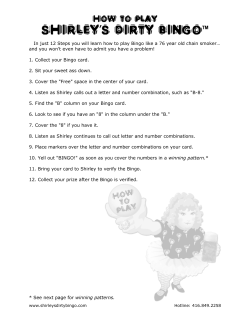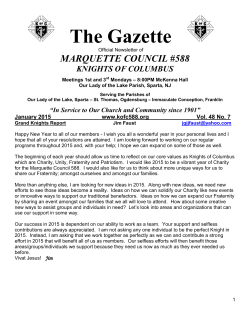
Instruction sheet
http://gslc.genetics.utah.edu Teacher Guide: Traits Bingo ACTIVITY OVERVIEW Abstract: In this bingo game students cross off or color bingo squares in response to questions about their traits. This activity is designed to be used as a review following An Inventory of My Traits, Generations of Traits, and A Tree of Genetic Traits (see Additional Resources), since these activities will familiarize students with the traits used in the game. Students will be able to play this game without having done these activities, however, if they are familiar with the traits listed in Prior Knowledge Needed. Module: Introduction to Heredity (Grades 5-7) Prior Knowledge Needed: Traits are inherited from parents and by extension, grandparents; familiarity with the following traits: hitchhiker’s thumb, cleft chin, attached and detached earlobes, widow’s peak, tongue rolling, freckles, hand clasping preference, dimples, curly or straight hair, ability to taste PTC © 2002 University of Utah Key Concepts: Traits are inherited physical characteristics; some traits are more common than others Materials: Bingo cards and questions; PTC paper and hard candies (if this trait has not already been tested) Appropriate For: Ages: 10 - 12 USA grades: 5 - 7 Prep Time: 20 minutes Class Time: 30 minutes Activity Overview Web Address: http://gslc.genetics.utah.edu/teachers/tindex/ overview.cfm?id=traitbingo Genetic Science Learning Center, 15 North 2030 East, Salt Lake City, UT 84112 http://gslc.genetics.utah.edu Teacher Guide: Traits Bingo TABLE OF CONTENTS Page 1-2 Pedagogy A. Learning Objectives B. Background Information C. Teaching Strategies Additional Resources 3 A. Activity Resources Materials 3 A. Detailed Materials List B. Materials Preparation Guide Standards 3-4 A. U.S. National Science Education Standards B. AAAS Benchmarks for Science Literacy C. Utah Elementary Science Core Curriculum Grade 5 Teacher References 5 A. Bingo Questions Student Pages • Bingo Card © 2002 University of Utah S-1 Genetic Science Learning Center, 15 North 2030 East, Salt Lake City, UT 84112 http://gslc.genetics.utah.edu Teacher Guide: Traits Bingo I. PEDAGOGY A. Learning Objectives • Students will inventory their own inherited traits. • Students will compare their traits with others. • Students will determine which traits are most and least common in the class. B. Background Information A pictorial reference for the traits in this activity is available in Comparing Inherited Human Traits (see Additional Resources). For information on the inheritance of traits and on the inheritance patterns of traits in this activity, see Background Information in An Inventory of My Traits (see Additional Resources). For information about PTC, see Background Information in A Tree of Genetic Traits (see Additional Resources). C. Teaching Strategies 1. Timeline • Three weeks before activity: - Order PTC paper if you have not already tested for this trait in your class (see Material Preparation Guide) • Day before activity: - Copy Bingo cards (page S-1) - Make numbered slips of paper or cards to use to call Bingo questions at random (optional) - Purchase hard candy (if testing for the PTC-tasting trait) • Day of activity: - Test for PTC-tasting ability (if you have not done so previously) - Review with students the traits used in the activity - Distribute Bingo cards to students - Read out Bingo questions (page 5) in order or at random until a student obtains a bingo © 2002 University of Utah Genetic Science Learning Center, 15 North 2030 East, Salt Lake City, UT 84112 Page 1 of 5 http://gslc.genetics.utah.edu Teacher Guide: Traits Bingo 2. Classroom Implementation • Have students test for the ability to taste PTC, if you have not already done so. - Give each student a piece of PTC paper and instruct them to place the paper on the tip if their tongue to see if they can taste the chemical. - Hand out a hard candy to each student, as the taste of PTC is bitter and slightly unpleasant. Teaching Tip: You may want to place small waste containers for PTC paper and candy wrappers around the room. • Review the following traits with students: - Ability to taste PTC - Hitchhiker’s thumb - Cleft chin - Attached and detached earlobes - Widow’s peak - Tongue rolling - Freckles - Hand clasping preference (left or right thumb on top) - Dimples - Curly or straight hair • Distribute one or more Bingo cards to each student. • Instruct students not to mark any squares unless told to do so (otherwise they may begin to color in the traits they possess and a bingo will be quickly obtained). • Read the Bingo questions (page 5) one by one (in order or randomly), instructing students to mark the squares with an X or color them in. Teaching Note: You may also choose to use numbered cards or slips of paper for students to draw at random. When a particular number is drawn, read the corresponding question from the list of Bingo questions. • Continue to read Bingo questions (page 5) until a student obtains a bingo. 3. Common Misconceptions: • Students may think that they inherit traits from aunts, uncles, cousins and siblings because family members point out the resemblance between students and their relatives. In fact, traits are only inherited from parents, and, by extension, grandparents. Questions #5 and #6 aim to clear up this misconception should it exist. © 2002 University of Utah Genetic Science Learning Center, 15 North 2030 East, Salt Lake City, UT 84112 Page 2 of 5 http://gslc.genetics.utah.edu Teacher Guide: Traits Bingo II. ADDITIONAL RESOURCES A. Activity Resources - linked from the online Activity Overview: http://gslc.genetics.utah.edu/teachers/tindex/overview.cfm?id=traitbingo • Teacher Guide: An Inventory of My Traits • Teacher Guide: A Tree of Genetic Traits • Teacher Guide: Generations of Traits • Teacher Guide: Comparing Inherited Human Traits - A pictoral reference to traits inventoried in this activity. III. MATERIALS A. Detailed Materials List • PTC paper (if you have not already tested for PTC tasting) – one paper per student • Hard candy (if testing for PTC tasting) – one per student • Bingo cards (page S-1) – one or more per student • Bingo Questions (page 5) • Cards or slips of paper numbered 1–18 (optional) B. Material Preparation Guide PTC paper can be ordered from: • Sargent Welch - $1.50 per vial of 100 (www.sargentwelch.com) • Carolina Math and Science - $3.45 per packet of 100 (www.carolina.com) • Ward’s Natural Science - $1.05 per vial of 100 (http://www.wardsci.com) IV. STANDARDS A. U.S. National Science Education Standards Grades 5-8: • Content Standard C: Life Science - Reproduction and Heredity; every organism requires a set of instructions for specifying its traits. Heredity is the passage of these instructions from one generation to the other. B. AAAS Benchmarks for Science Literacy Grades 3-5: • The Living Environment: Heredity - some likenesses between children and parents, such as eye color in human beings, or fruit or flower color in plants, are inherited. © 2002 University of Utah Genetic Science Learning Center, 15 North 2030 East, Salt Lake City, UT 84112 Page 3 of 5 http://gslc.genetics.utah.edu Teacher Guide: Traits Bingo Grades 6-8: • The Human Organism: Human Identity - human beings have many similarities and differences. C. Utah Elementary Science Core Curriculum Grade 5 Intended Learning Outcomes Students will be able to: 1. Use Science Process and Thinking Skills a. Observe simple objects, patterns, and events and report their observations. d. Compare things, processes, and events. Standard V: Students will understand that traits are passed from the parent organisms to their offspring, and that sometimes the offspring may possess variations of these traits that may help or hinder survival in a given environment. Objective 1: Using supporting evidence, show that traits are transferred from a parent organism to its offspring. a. Make a chart and collect data identifying various traits among a given population. V. CREDITS Activity created by: Molly Malone, Genetic Science Learning Center Funding: A Howard Hughes Medical Institute Precollege Science Education Initiative for Biomedical Research Institutions Award (Grant 51000125). © 2002 University of Utah Genetic Science Learning Center, 15 North 2030 East, Salt Lake City, UT 84112 Page 4 of 5 http://gslc.genetics.utah.edu Teacher References: Traits Bingo A. Bingo Questions You may ask the questions in order, at random, or have students draw numbers. 1. Color the square marked I cross my right thumb over my left when I clasp my hands if this describes you. 2. Color the square marked Shared trait-Left if you share a trait with the person sitting to your left. 3. Color the square marked Least common trait if you have a trait that not many people in the class share. 4. Color the square marked Neighbor can not taste PTC if you are sitting next to someone who can not taste PTC. 5. Color the square or squares naming the relatives from whom you do not inherit traits 6. Color the square or squares naming the relatives from whom you do inherit traits 7. Color the square marked Hitchhiker’s thumb if you have this trait. 8. Color the square marked Trait in common - Right if you and your neighbor to the right share a common trait. 9. Find the two squares for tasting, or not tasting, PTC and color the one that applies to you. 10. Find the two squares describing earlobes and color the one that applies to you. 11. Color the square marked Widow’s peak if you have this trait. 12. Color the square marked Can not roll tongue if you have this trait. 13. Color the square marked I have a different trait than the person sitting next to me if this describes you. 14. Find the two squares describing hair texture and color the one that applies to you. 15. Color the square marked Freckles if you have this trait. 16. Color the square marked Dimples if you have this trait. 17. Color the square marked Cleft chin if you have this trait. 18. Color the square marked I cross my left thumb over my right when I clasp my hands if this describes you. © 2002 University of Utah Genetic Science Learning Center, 15 North 2030 East, Salt Lake City, UT 84112 Page 5 of 5 Name Date o T Color or mark with an “x” the squares below when instructed to do so The square marked “free” is a free space B I N G O Aunt Hitchhiker’s thumb Widow’s peak Freckles Mother Can not taste PTC Curly hair Neighbor can not taste PTC Straight hair Grandmother Free Attached earlobes Dimples Cleft chin Can taste PTC Uncle Can not roll tongue Shared trait - Left Trait in common Right I cross my right thumb over my left when I clasp my hands Father I have a different trait than the person sitting next to me Detached earlobes © 2002 University of Utah http://gslc.genetics.utah.edu I cross my left thumb over my Least common right when I trait clasp my hands Permission granted for classroom use. S-1
© Copyright 2025









